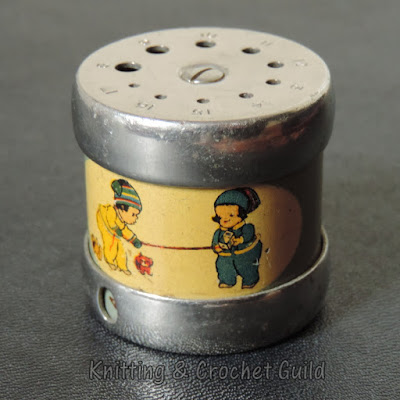 |
| The Viyella Knitting Recorder and Needle Gauge |
Viyella was a fabric woven from a blend of 55% merino wool and 45% cotton, introduced in the 1890s by William Hollins & Co., whose headquarters were in Nottingham. In the early days, it was mostly sold as ready-made clothing, and knitted items such as gloves and jumpers were also advertised. By 1922, Viyella knitting yarn was being sold directly to the public. The Queen magazine, in November 1922, said:
All who know the famous "Viyella" flannel — and who does not? — ought to know of "Viyella" knitting yarn. This, as the name implies, is exactly the same beautiful yarn as that from which the flannel itself is woven, and is, therefore, unequalled for lightness and dainty softness, combined with durability.
The company started to publish pattern leaflets in the early 1930s, and also developed the "Knitting Recorder and Needle Gauge". Mine says 'Patents Pending' on the drum; the patent was applied for in 1932 and granted in 1934 (Number GB408594). The patent was for 'Improvements in number indicating devices for the use of knitters, or use as a calendar or for scoring points in a game, or for like purposes.' The applicants were the manufacturer, William Hollins and Co., and the man who was presumably the inventor, Horace Josiah Ball of Knowle Park House, Kimberley, Nottinghamshire. In the 1939 register of the British population, Horace Ball is listed as a Typewriter Works Manager; he was named as an applicant on about a dozen other patents, for improvements to typewriters.
The photo above shows that, as the patent says 'numbers are engraved or stamped round the two ends of the cylindrical body in such a position that they are covered by the rims of the end covers, and each of the latter is formed with a single opening so disposed, that by turning the covers each will expose one number on the body at a time.' The patent suggests that: 'The device may be used by knitters for recording the number of courses [rows?] knitted, and the number of stitches knitted in the last course, or other information respecting the progress of the work, when the latter is laid down, so as to obviate the necessity for counting when the work is taken up again.' In fact, the numbers run from 1 to 24, which is not what you want in a counter: a counter should start at 0, and probably you would want the potential for counting more than 24 rows, too.
The patent suggests that the gadget could also be a needle gauge: 'For the use of knitters, the end covers may be formed with a series of holes, which are graduated in size and are numbered so as to form a knitting pin gauge.' The top of the recorder has holes for British needle sizes 1 to 7 (7.5mm. to 4.5mm.) and the base (below) measures sizes 8 to 17 (4mm. to 1.4mm.).
 |
| Base of knitting recorder, showing needle gauge |
The recorder is about 4cm. in diameter and about 4cm. high, and made of steel (I tested it with a fridge magnet), and so is quite hefty, even though the cylinder is hollow. Perhaps it's too large and heavy to want to carry around in your knitting bag, but it does feel very satisfying in the hand, like a worry egg.
A Knitting Recorder exactly like mine was illustrated on the back of a Viyella crochet pattern (for a very smart jumper and matching cap) in the Knitting & Crochet Guild collection. The leaflet was advertised in April 1933.
 |
| Viyella leaflet 144 |
The description of the recorder doesn't mention using it for counting rows at all. 'The left-hand figure is set on the number of increasings or decreasings to be made. The right-hand figure begins at one, and is moved up one as each increase or decrease is made, until it reaches the same number.' A novel idea, but I still feel that starting the count at 1 rather than 0 is liable to lead to errors.
 |
| Viyella Two-in-One Recorder, illustrated on leaflet 144 |
 |
| Viyella Knitting Recorder, with children playing |
I think that this version may be slightly later than mine; although some of this type still say 'Patents Pending' on the drum, others give the patent number.
Viyella Knitting Recorders are offered regularly on eBay, so they must have sold quite well originally. But I suspect that they were only made for a few years in the 1930s - I am sure that production would have stopped during World War 2, when steel was a vital raw material. My needle gauge is a very nice thing to have, even if it is (in my view) not much use as a counter.



